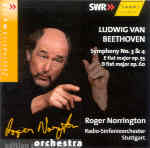Roger Norrington’s new Eroica blows away his previous recording on EMI. Part of the reason stems from the fact that where previously he had to make do with the London Classical Fakers–I mean, players–he now has a real orchestra that knows the music well enough to give him what he asks without struggling with the mere mechanics of their grotty, anemic-sounding period instruments. But Norrington also has learned a few tricks since that earlier reading. Take the very opening: instead of the usual prominent chugging accompaniment, Norrington has the violins playing legato, producing a mere pulsation, and this allows him to phrase whole tunes rather than bar by bar. The result is a swift tempo that never sounds rushed and an exposition that seems to pass in one large breath. And once he gets going, the movement is full of imaginative touches. To take one example, listen to the horn announce the recapitulation as if at the head of a victorious army turning the tide of battle at the last instant. Moments like these confirm Norrington’s understanding of Beethoven’s sonata-form dialectic.
The very fast funeral march comes off as more militant than funereal, but the two trio sections (including the great fugue) seldom have sounded better integrated into the music’s inexorable flow. Three fabulous horn players make something very special out of the scherzo’s trio, and the swift finale once again demonstrates Norrington’s willingness to subordinate the dictates of historical performance pedagogy to the demands of musical spontaneity. The coda, so often a letdown in the metronomic hands of the “authentic” crowd, here provides an exciting conclusion to a performance that cheats the clock at every point–a very impressive accomplishment indeed.
Norrington’s lithe and athletic rendition of the Fourth symphony reveals the same sympathetic approach that characterizes the Eroica. The first movement introduction acquires an extra air of menace by gently leaning on the low horn notes, while the quiet timpani rolls that usher in the recapitulation are unusually clear, but never too loud or obvious. Generous contributions from trumpets and drums in general add necessary weight and splendor to the orchestra textures, but they never blast or obliterate important details in the strings and woodwinds. The Adagio belies its tempo designation, but it’s hard to resist such lyric urgency. No such reservation characterizes the last two movements: the scherzo benefits from Norrington’s pep, and he relaxes nicely into the trios. And he chooses an ideal tempo for the finale–it’s fast but never degenerates into a scramble. In fact, this seems just what Beethoven meant by “Allegro ma non troppo”.
The SWR engineers have captured this entire Beethoven cycle with some of the best live sound ever to grace this music. The necessarily close perspectives exclude most audience noise but maintain excellent balances and exemplary clarity. The only problem is the excessive amount of applause retained after each symphony. It’s nice to know that the audience had a good time, but the excellence of the performances speaks for itself, and each listener should be left to draw his own conclusions. First rate! [6/5/2003]
































